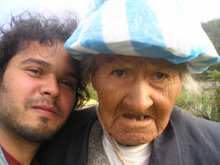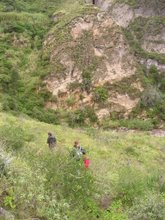
"The City 2600 meters closer to the stars" is what it is also called. 9 Millions habitants live here, all from diffirent backgrounds: indians, mestisos, blacks, whites, yellows, and the few tourists walking around. One can see if the tourists walking around have been here for a while or have just arrived for the newcomers walk tensed, look around for anything supicious and hardly smile or greet. But if you, as a tourist, take a little time, say a week, to get to know the city and its people, you will feel no threats nor tension, only if you look for it.
 It appears to me that Colombians, better said Rolos (people from Bogotá) have had a long period of very bad times behind them with the civil war, corruption, poverty, drugs and its drugwars, (that still continue today althought is seems to have entered a period of tranquility) that they don't want to act bad anymore. They have had enough and they don't want to live that downward spiral no more. That maybe one of the reasons why there are so many students walking around. And also for the policy that now is used in Bogotá: the poor people are not allowed to enter the city and are kept in places citypeople won't show up.
It appears to me that Colombians, better said Rolos (people from Bogotá) have had a long period of very bad times behind them with the civil war, corruption, poverty, drugs and its drugwars, (that still continue today althought is seems to have entered a period of tranquility) that they don't want to act bad anymore. They have had enough and they don't want to live that downward spiral no more. That maybe one of the reasons why there are so many students walking around. And also for the policy that now is used in Bogotá: the poor people are not allowed to enter the city and are kept in places citypeople won't show up.
 It appears to me that Colombians, better said Rolos (people from Bogotá) have had a long period of very bad times behind them with the civil war, corruption, poverty, drugs and its drugwars, (that still continue today althought is seems to have entered a period of tranquility) that they don't want to act bad anymore. They have had enough and they don't want to live that downward spiral no more. That maybe one of the reasons why there are so many students walking around. And also for the policy that now is used in Bogotá: the poor people are not allowed to enter the city and are kept in places citypeople won't show up.
It appears to me that Colombians, better said Rolos (people from Bogotá) have had a long period of very bad times behind them with the civil war, corruption, poverty, drugs and its drugwars, (that still continue today althought is seems to have entered a period of tranquility) that they don't want to act bad anymore. They have had enough and they don't want to live that downward spiral no more. That maybe one of the reasons why there are so many students walking around. And also for the policy that now is used in Bogotá: the poor people are not allowed to enter the city and are kept in places citypeople won't show up.  One of the 'barrios' where they live is called Ciudad Bolívar, in the South of Bogotá. Even though French, Canadian and Suisse fundations help to create a wellfare (health, food and education) in that area, it is unwise to enter it, let alone at night. Because like in every big City criminality flourishes at night. But in Bogotá it is more likely to encounter a gun instead of a nife, and if it is a nife it most likely will be part of a group of five to ten, twelf angry men. But don't let this scare you nor believe everything you read or hear; it might as well be a group of twelf foxy women ready to dance with you.
One of the 'barrios' where they live is called Ciudad Bolívar, in the South of Bogotá. Even though French, Canadian and Suisse fundations help to create a wellfare (health, food and education) in that area, it is unwise to enter it, let alone at night. Because like in every big City criminality flourishes at night. But in Bogotá it is more likely to encounter a gun instead of a nife, and if it is a nife it most likely will be part of a group of five to ten, twelf angry men. But don't let this scare you nor believe everything you read or hear; it might as well be a group of twelf foxy women ready to dance with you. Around Latin-America Colombia is known as Locombia, Bogatá as Drogotá and the people are known for their wild parties and friendliness. They are curious, ask questions and are helpfull. They seem fearless but alegre, warm and willing to share what they can: food, shelter, drinks, knowlegde, anything. The countryside is endlesly versatile: from mountains and vulcanos with white summits to black and white beaches, jungle and desertlike areas. The land incredibly vertile displaying colours of all kinds. But one has to travel through it to get a glimpse of the beauty of the land and its people. Fearless and curious.
Around Latin-America Colombia is known as Locombia, Bogatá as Drogotá and the people are known for their wild parties and friendliness. They are curious, ask questions and are helpfull. They seem fearless but alegre, warm and willing to share what they can: food, shelter, drinks, knowlegde, anything. The countryside is endlesly versatile: from mountains and vulcanos with white summits to black and white beaches, jungle and desertlike areas. The land incredibly vertile displaying colours of all kinds. But one has to travel through it to get a glimpse of the beauty of the land and its people. Fearless and curious.
































